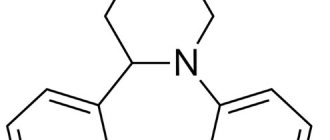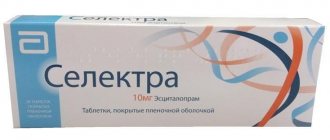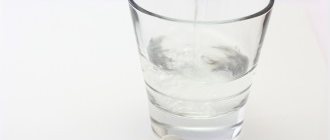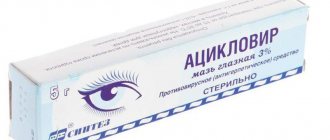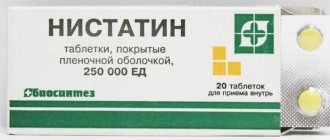Amiviren (tablet form) belongs to the group of antiviral drugs for systemic use. Important features of the medicine from the instructions for use:
How to dissolve vascular plaques, normalize blood circulation, blood pressure and forget the way to the pharmacy
- Sold only with a doctor's prescription
- During pregnancy: with caution
- When breastfeeding: contraindicated
- In childhood: with caution
- For liver dysfunction: with caution
- If renal function is impaired: with caution
Release form and composition
Amiviren is available in the form of film-coated tablets: white, biconvex, round (150 mg) or oval with a score on one side (300 mg), white or white with a yellowish tint on the cross-section (10 pieces in a blister pack made of polyvinyl chloride and aluminum foil, 1, 2, 3, 5, 6 or 10 packs in a cardboard box; 60 or 100 pieces in a polymer jar, 1 jar in a corrugated cardboard box (for hospitals)).
Composition of 1 tablet:
- Active ingredient: lamivudine – 150 mg or 300 mg;
- Auxiliary components: pregelatinized starch, microcrystalline cellulose, sodium carboxymethyl starch, magnesium stearate, colloidal silicon dioxide;
- Film shell composition: copovidone, polydextrose, hydroxypropyl methylcellulose, caprylic/capric acid triglyceride, titanium dioxide, macrogol 6000.
Contraindications
Absolute:
- Impaired renal function (creatinine clearance less than 30 ml/min);
- Children under 3 years of age and body weight less than 14 kg;
- Lactation period;
- Hypersensitivity to the components of the drug.
Relative (Amiviren is used with caution):
- Renal failure with CC 30-50 ml/min;
- Severe liver cirrhosis caused by the hepatitis B virus;
- Elderly age;
- Pregnancy period.
Comparison with tenofovir
Acts against the most common strain of HIV-1. Contraindications, unlike amiviren, include diabetes mellitus and children under 12 years of age.
It is effective only in combinatorial regimens, has a high safety profile, good bioavailability and absorption. The medication reaches therapeutic concentrations in serum after oral administration for an hour and is excreted after 17 hours.
Read further: Instructions for tenofovir
Directions for use and dosage
Amiviren can only be prescribed by a specialist experienced in treating HIV infection.
The tablets are taken orally, swallowed completely, without division, before, during or after meals. Children and patients who have difficulty swallowing a whole tablet can take the drug in crushed form with the addition of a small amount of liquid or semi-solid food.
Recommended doses:
- Adult patients and children over 12 years of age weighing more than 30 kg: 150 mg twice a day or 300 mg per day once;
- Children weighing 21-30 kg: 225 mg per day;
- Children weighing 14-21 kg: 150 mg per day once.
In case of moderate renal failure, the initial dose of Amiviren should not exceed 150 mg per day. In severe renal failure, this dosage form of lamivudine is contraindicated.
For moderate and severe liver failure, no dose adjustment is required.
Conditions for dispensing from pharmacies
Dispensed by prescription.
Information about the drug is generalized, provided for informational purposes and does not replace official instructions. Self-medication is dangerous to health!
The rarest disease is Kuru disease. Only members of the For tribe in New Guinea suffer from it. The patient dies of laughter. The disease is believed to be caused by eating human brains.
According to many scientists, vitamin complexes are practically useless for humans.
The human brain weighs about 2% of the total body weight, but it consumes about 20% of the oxygen entering the blood. This fact makes the human brain extremely susceptible to damage caused by a lack of oxygen.
According to statistics, on Mondays the risk of back injuries increases by 25%, and the risk of a heart attack by 33%. Be careful.
An educated person is less susceptible to brain diseases. Intellectual activity promotes the formation of additional tissue that compensates for the disease.
When lovers kiss, each of them loses 6.4 calories per minute, but at the same time they exchange almost 300 types of different bacteria.
Dentists appeared relatively recently. Back in the 19th century, pulling out diseased teeth was the responsibility of an ordinary hairdresser.
In order to say even the shortest and simplest words, we use 72 muscles.
According to WHO research, talking on a mobile phone for half an hour every day increases the likelihood of developing a brain tumor by 40%.
When we sneeze, our body stops working completely. Even the heart stops.
Smiling just twice a day can lower your blood pressure and reduce the risk of heart attacks and strokes.
A person taking antidepressants will, in most cases, become depressed again. If a person has coped with depression on his own, he has every chance to forget about this condition forever.
If your liver stopped working, death would occur within 24 hours.
The well-known drug Viagra was originally developed for the treatment of arterial hypertension.
During operation, our brain expends an amount of energy equal to a 10-watt light bulb. So the image of a light bulb above your head at the moment an interesting thought arises is not so far from the truth.
Every year in December-February there is an outbreak of influenza. Until this moment, the population is actively offered from the pages of the media and TV screens to be vaccinated against certain diseases.
Side effects
- Gastrointestinal tract: often - vomiting, diarrhea, pain in the upper abdomen, nausea, loss of appetite; rarely - increased serum amylase activity, pancreatitis;
- Respiratory system: often – nasal symptoms, cough, respiratory tract infections;
- Nervous system: often – insomnia, headache; very rarely - paresthesia; isolated cases - peripheral neuropathy;
- Musculoskeletal system and connective tissue: often – muscle disorders, arthralgia; rarely - rhabdomyolysis;
- Metabolism: often - increased serum concentration of lactic acid; uncommon – hyperglycemia, hypertriglyceridemia, insulin resistance, hypercholesterolemia; rarely - lactic acidosis; frequency unknown – redistribution or accumulation of subcutaneous fat;
- Hepatobiliary system: infrequently - transient increase in the activity of liver enzymes; rarely - hepatitis;
- Hematopoietic organs: uncommon – anemia, neutropenia, thrombocytopenia; very rarely - partial red cell aplasia;
- Allergic reactions: angioedema;
- Skin and its derivatives: often – baldness, rash;
- Other reactions: often - fatigue, fever, malaise.
Cases of osteonecrosis have been reported in patients with advanced HIV infection or during long-term combination antiretroviral therapy (incidence unknown).
Amiviren
Treatment with the drug should be carried out by a doctor experienced in caring for patients with HIV infection.
The use of lamivudine as monotherapy is not recommended.
Patients should be warned that treatment with antiretroviral drugs, including lamivudine, does not prevent the risk of transmitting HIV to others through sexual contact or blood transfusion. Therefore, patients should take appropriate precautions.
Patients receiving lamivudine or other antiretroviral drugs may develop opportunistic infections or other complications and should be closely monitored by a physician experienced in treating HIV infection.
Although the etiology is considered multifactorial (including corticosteroid use, alcohol consumption, severe immunosuppression, increased body mass index), cases of osteonecrosis have been reported particularly in patients with advanced HIV disease and/or as a result of long-term combination antiretroviral therapy. If pain and aches in the joints, stiffness in the joints or difficulty moving occur, patients should seek medical help.
Cases of lack of virological response and the emergence of resistance at an early stage have been reported when prescribing triple nucleoside therapy (a combination of lamivudine with tenofovir disoproxil fumarate and abacavir, and lamivudine with tenofovir disoproxil fumarate and didanosine) when taking the drugs once a day.
In vitro and in vivo conditions have revealed the ability of nucleotide and nucleoside analogues to cause mitochondrial damage to varying degrees. Cases of mitochondrial dysfunction have been observed in HIV-negative children exposed to nucleoside analogs in utero or immediately after birth.
In patients with moderate to severe renal impairment, the plasma concentration of lamivudine is increased due to decreased clearance of the drug, so dose adjustment is required. In patients with impaired renal function, creatinine clearance
In patients with moderate to severe hepatic impairment, no dose reduction of lamivudine is required unless liver impairment is accompanied by renal impairment.
There have been several cases of pancreatitis in patients receiving lamivudine. However, it remains unclear whether this complication is caused by lamivudine or by HIV infection itself. If abdominal pain, nausea, vomiting, or characteristic changes in biochemical parameters occur in a patient receiving lamivudine, pancreatitis should be excluded. The drug should be suspended until the diagnosis of pancreatitis is excluded.
In HIV-infected patients (mainly women) taking antiretroviral drugs from the group of nucleoside analogues as monotherapy or in combination with lamivudine, cases of lactic acidosis have been described, which is usually accompanied by severe hepatomegaly and fatty degeneration of the liver, including fatal outcomes. . Symptoms that may indicate the development of lactic acidosis include: general weakness, loss of appetite, sudden unexplained weight loss, gastrointestinal and respiratory problems (shortness of breath). If clinical or laboratory signs of lactic acidosis or liver dysfunction (including hepatomegaly and fatty liver disease, even in the absence of a marked increase in liver transaminases), lamivudine should be discontinued.
Caution should be exercised when prescribing nucleoside analogues to patients with concomitant hepatitis C receiving interferon alpha and ribavirin due to the high risk of developing lactic acidosis. Such patients should be subject to close clinical and laboratory monitoring.
In some patients, combination antiretroviral therapy may be accompanied by redistribution/accumulation of subcutaneous fat, including a decrease in peripheral fat and an increase in visceral fat, weight loss of the limbs and face, enlarged mammary glands, and fat deposition along the back of the neck and back (buffalo hump). '), as well as an increase in the concentration of glucose lipids in the blood plasma. Although all drugs in the protease inhibitor and nucleoside reverse transcriptase inhibitor classes may cause one or more of the above adverse reactions associated with the common syndrome often referred to as lipodystrophy, accumulating evidence suggests that there are differences among individual members of these drug classes in the ability to cause these reactions. unwanted reactions. It should also be noted that lipodystrophy syndrome has a multifactorial etiology; for example, stage of HIV infection, advanced age, and duration of antiretroviral therapy play an important, possibly synergistic role in the development of this complication. The long-term consequences of these adverse reactions have not yet been established. Clinical examination of patients should include assessment of physical signs of redistribution of adipose tissue. Plasma glucose lipid concentrations should also be measured. Lipid metabolism disorders must be corrected based on their clinical manifestations.
In HIV-infected patients with severe immunodeficiency, during the initiation of antiretroviral therapy, an exacerbation of the inflammatory process due to asymptomatic or indolent opportunistic infection is possible, which can cause serious deterioration of the condition or aggravation of symptoms. As a rule, such reactions were observed in the first weeks or months after the start of antiretroviral therapy. The most significant examples are cytomegalovirus retinitis, generalized and/or focal mycobacterial infection, and Pneumocystis pneumonia. Any symptoms of inflammation must be immediately identified and treatment initiated without delay.
Autoimmune diseases (such as Graves' disease, Wagner's syndrome, polymyositis, Guillain-Barre syndrome, etc.) were observed against the background of immune restoration, but the time of initial manifestations varied, and the disease could occur many months after the start of therapy and have an atypical course.
In patients infected simultaneously with HIV and the hepatitis B virus, clinical or laboratory signs of relapse of hepatitis may appear after cessation of lamivudine therapy, which can have serious consequences if liver function decompensates. After completion of lamivudine therapy in patients infected with HIV and hepatitis B virus, it is necessary to monitor biochemical indicators of liver function and markers of hepatitis B virus replication for several months.
According to international recommendations (Center for Disease Control, June 1998), if infection is likely through the blood of an HIV-infected person (for example, through an injection needle), it is necessary to urgently (within 1-2 hours from the moment of infection) prescribe combination therapy with zidovudine and lamivudine. In case of a high risk of infection, a drug from the group of protease inhibitors should be included in the antiretroviral therapy regimen. Prophylactic treatment is recommended for 4 weeks. There is insufficient data on the effectiveness of preventive treatment after accidental HIV infection; no controlled studies have been conducted. Despite the rapid initiation of treatment with antiretroviral drugs, the possibility of seroconversion cannot be excluded.
No special studies have been conducted to study the effect of the drug on the ability to drive a car or operate moving mechanisms. However, based on the pharmacological properties of lamivudine, such an effect is unlikely. However, when assessing the patient's ability to drive a car and move machinery, his general condition should be taken into account, as well as the nature of the adverse reactions of lamivudine.
special instructions
Amiviren is not used simultaneously with zidovudine for anemia (hemoglobin level less than 4.65 mmol/l) or neutropenia (neutrophil count less than 750/μl).
If side effects from the digestive system (nausea, vomiting, abdominal pain) or an increase in the plasma level of pancreatic enzymes occur, the drug should be discontinued and not used until the diagnosis of pancreatitis has been ruled out.
Amiviren does not prevent the possibility of acquiring HIV infection through blood or sexual contact.
During treatment, secondary infection may develop.
There is no experience with the use of the drug in children under 3 months of age. If renal function is impaired in childhood, the dosage regimen is adjusted in the same proportions as in adult patients.
Reviews from people
Two months ago, a friend suffered from a complex viral infection, which caused complications. The friend felt very bad and was almost ready to die, but this continued until a doctor who knew about diseases was found who prescribed him the medicine Amiviren.
Only with the help of these tablets did my friend finally recover from a long and complex illness. Now he is involved in professional sports, monitors his health and, in general, is a very successful person and does not like to remember his illness, which could cause certain complications. Amiviren is a real treasure!
Vitaly Khlebnikov
It so happened that one of my friends fell ill with hepatitis B. As you know, this is a very serious disease and, of course, you wouldn’t wish this even on your enemy. An acquaintance was very upset when he learned about his diagnosis, he was almost hysterical, although the doctor said that everything would be fine and he would be cured of this disease. The doctor prescribed a friend to take the drug Amiviren. An acquaintance was treated with the drug for six months, but it was worth it.
Thank God, the diagnosis was not confirmed at the next doctor’s appointment and everything turned out okay.
The friend successfully recovered; the drug did not cause any side effects; in general, the treatment was successful. My friend is now full of strength and health, which I am very happy about. The drug Amiviren is quite expensive, like all drugs of this type, but it really helps. Amiviren is capable of ridding the human body of such a serious disease as hepatitis B, and this has been proven by many people. Vladimir Ivanov
Drug interactions
When taken together, lamivudine increases the duration of the therapeutic effect of zidovudine by 13% and increases its maximum plasma concentration by 28%.
With the simultaneous use of Amiviren with zidovudine and other antiviral drugs that are used in the treatment of HIV infections, synergism is observed.
Sulfonamides, didanosine and zalcitabine increase the risk of developing pancreatitis.
When administered concomitantly with isoniazid, dapsone, zalcitabine, didanosine or stavudine, the likelihood of peripheral neuropathy increases.
Trimethoprim increases plasma concentrations of lamivudine.
Amiviren - instructions for use of tablets, analogues, patient reviews, recipe
Amiviren belongs to a group of antiviral drugs used to treat HIV infection.
The main active ingredient of Amiviren is Tlamivudine.
Amiviren tablets have proven themselves well in combined treatment regimens for HIV 1 and 2. Penetrating into the cell, the drug is transformed into 5-triphosphate. It remains in this active form for up to 19 hours, which allows it to penetrate viral virions and block the synthesis of the DNA chain using reverse transcriptase.
When taken together with other antiretroviral drugs, a synergistic effect is achieved, which helps to achieve good results with conservative therapy. Amiviren has high absorption rates - 80-85%.
Lamivudine reaches its maximum concentration in blood plasma within 60 minutes after administration. The active substance even penetrates into the cerebrospinal fluid, therefore it has a complex antiviral effect on the entire body.
Antibiotic or not?
It is not an antibiotic, it is classified as an antiviral agent.
Compatibility of amiviren with alcohol
Drinking alcoholic beverages is strictly prohibited. Alcohol consumption reduces the effectiveness of antiretroviral therapy.
Also, possible negative consequences include the following:
- allergic reactions, up to anaphylactic shock;
- various central nervous system disorders - hallucinations, sleep disturbances, nightmares, dizziness, loss of consciousness, confusion of thinking;
- increased heart rate, increased blood pressure, arrhythmic disorders;
- altered liver tests, decreased creatinine clearance to critical values.
Interaction with other drugs
For the most part, this medication is not metabolized with other medications, the exception is a similar method of elimination using the organic cation transport system (for example, trimethoprim).
With zidovudine - its presence in plasma increases by 28%; it does not affect the characteristics of lamivudine.
Lamivudine preparations are incompatible with co-trimaxazole, zalcitabine, and cladribine.
Shelf life, storage conditions
The drug is good for 3 years, but you must look at the date of manufacture printed on the packaging and do not use it after this period.
It is important to store the medication out of the reach of children, maintaining a temperature range of up to +250C.
Amiviren analogues
There are many structural analogues of this drug that have other trade names, both domestic and imported, these include:
- Disaverox,
- Lamivudine-vial,
- Virocombe,
- Lamivudin-teva,
- Virolam,
- Zeffix,
- Kivexa,
- Combivir.
There are also analogues according to indications and contraindications, but which contain other active ingredients; they also differ in price range. You need to understand that the therapeutic effect does not depend on this, but is directly determined by the general course of the disease, the existing pathologies in the anamnesis, on the basis of which the specialist decides on the choice of drug.
The treatment regimen is prescribed according to HAART protocols and is selected individually for each patient.
Analogues include:
- Zidolam,
- Duovir,
- Viread,
- Tenofovir,
- Efavirenz.
Comparison with tenofovir
Acts against the most common strain of HIV-1. Contraindications, unlike amiviren, include diabetes mellitus and children under 12 years of age.
It is effective only in combinatorial regimens, has a high safety profile, good bioavailability and absorption. The medication reaches therapeutic concentrations in serum after oral administration for an hour and is excreted after 17 hours.
Read further: Instructions for tenofovir
Efavirenz and amiviren
Efavirenz actively inhibits HIV-1 reverse transcriptase and is absolutely ineffective against HIV-2. In plasma, therapeutic concentrations are reached within 3-5 hours. It is not used for severe liver failure; in general, it can be noted that this drug has more contraindications than amiviren.
Read further: Instructions for efavirenz with analogues, reviews
Patient reviews of amiviren
In general, reviews after using this medicine are positive. In most cases, there was a marked decrease in viral activity. Combination treatment regimens are the most effective.
The widely used regimen is tenofovir and amiviren plus efavirenz or nevitrapine; it has more positive reviews because it is much easier to tolerate, and side effects occur less frequently than when combined with stavudine instead of tenofovir.
All treatment regimens, and especially the compatibility of structural substances in drugs, are prescribed and determined by the doctor, and only he is able to assess the fullness of their side, therapeutic effects.
Read further: The first signs and symptoms of HIV in men and women in the early stages, incubation period
Source: https://lifetab.ru/amiviren-instruktsiya-po-primeneniyu-tabletok-analogi-otzyivyi-patsientov-retsept/
